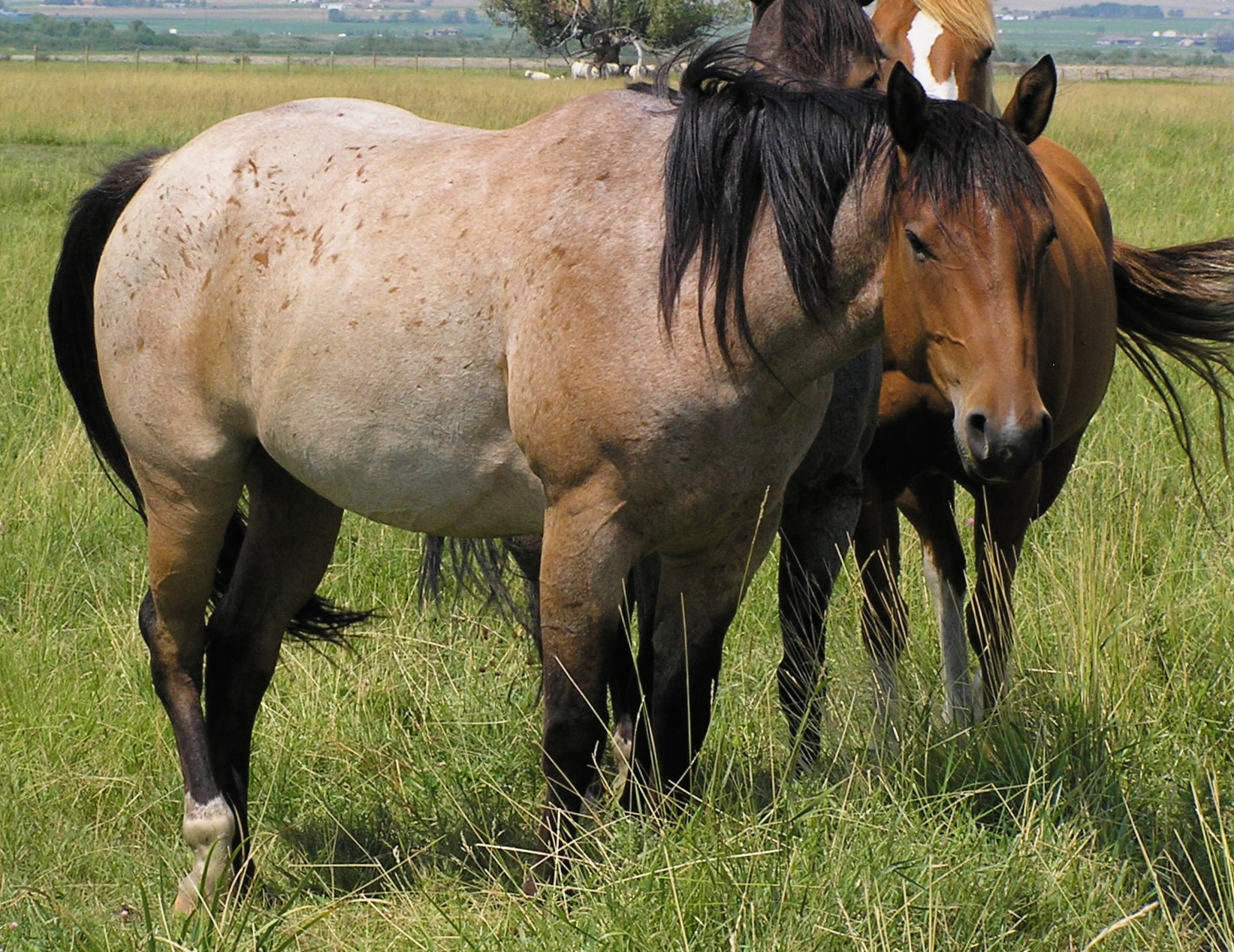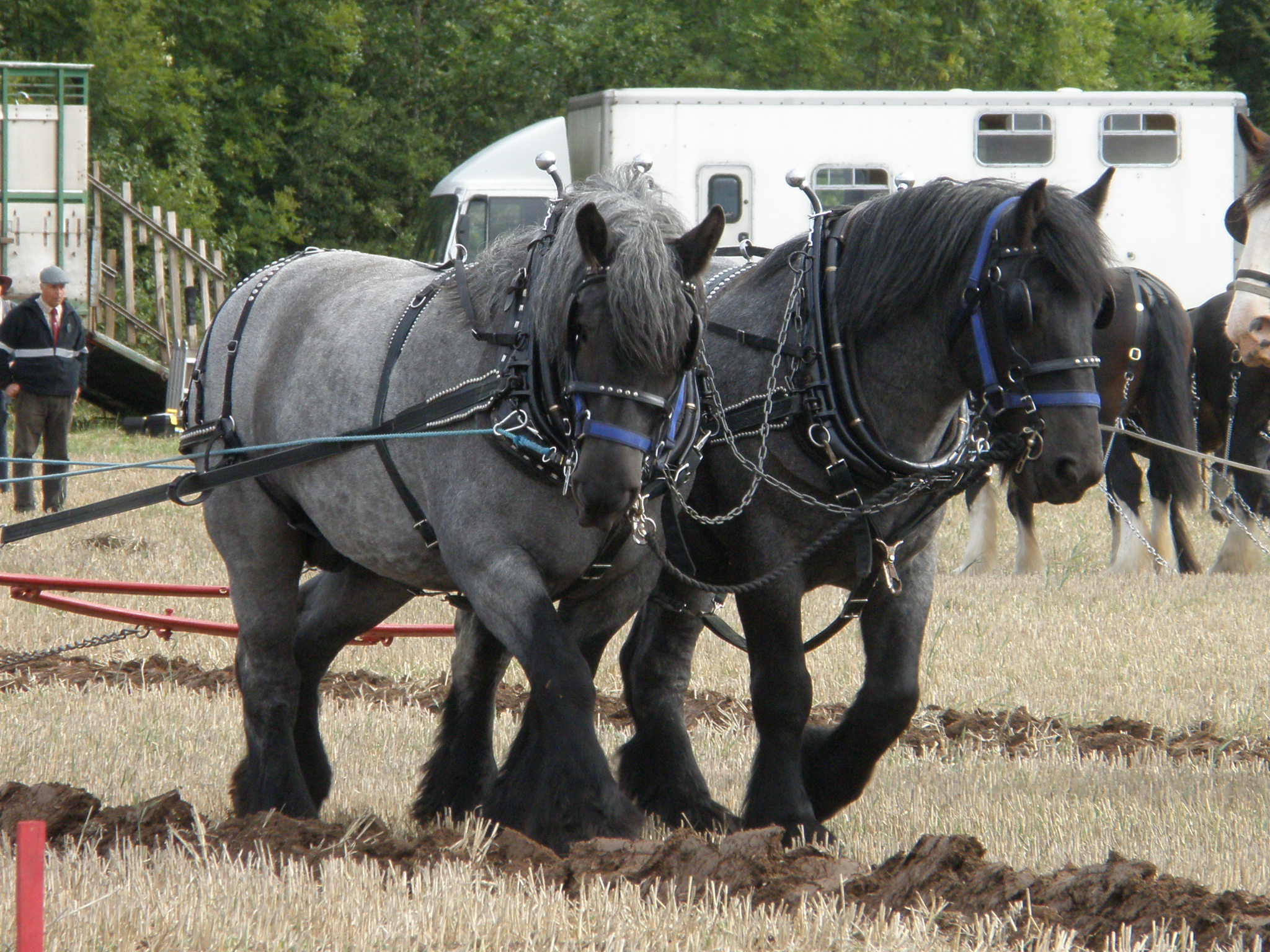|
Blue Grey (cattle)
The Blue Grey is a cattle hybrid traditional in south-western Scotland and north-western England. It is blue roan in colour, and results from breeding a black Galloway cow to a white Shorthorn bull. It is reared principally as a suckler cow, and is particularly well suited to upland grazing. History In south-western Scotland and north-western England, Shorthorn bulls were used from the early nineteenth century on black Galloway cows to produce vigorous hybrid calves. If the bull was white, the calf was blue roan in colour; these were easily recognisable and were much in demand. In the later nineteenth century, selection of the Whitebred Shorthorn was begun specifically to supply white sires for production of these calves. Characteristics The Blue Grey is blue roan in colour, and is polled (without horns). Cows have high amounts of body fat compared to other hybrids in similar overall condition, and are able to produce adequate quantities of milk even on poor grazing. U ... [...More Info...] [...Related Items...] OR: [Wikipedia] [Google] [Baidu] |
Roan (color)
Roan is a coat color found in many animals, including horses, cattle, antelope, cat and dogs. It is defined generally as an even mixture of white and pigmented hairs that do not "gray out" or fade as the animal ages."''roan'', ''a''. and ''n.1''" Oxford English Dictionary. 2nd edition 1989. OED Online. Oxford University Press. 3 June 2008. . There are a variety of genetic conditions which produce the colors described as "roan" in various species. Roan horses A horse with intermixed white and colored hairs of any color is usually called a roan. However, such mixtures, which can appear superficially similar, are caused by a number of separate genetic factors. Identifiable types of roans include true or classic roan, varnish roan, and rabicano, though other currently unknown factors may be responsible for ambiguous "roaning." Gray horses, which become lighter as they age until their hair coat is nearly completely white, may be confused with roans when they are young. Duns, whic ... [...More Info...] [...Related Items...] OR: [Wikipedia] [Google] [Baidu] |
Polled (livestock)
Polled livestock are livestock without horns in species which are normally horned. The term refers to both breeds and strains that are naturally polled through selective breeding and also to naturally horned animals that have been disbudded. Natural polling occurs in cattle, yaks, water buffalo, and goats, and in these animals it affects both sexes equally; in sheep, by contrast, both sexes may be horned, both polled, or only the females polled. The history of breeding polled livestock starts about 6000 years BC. Terminology The archaic term or is sometimes used to refer to hornless livestock (especially cattle) in folk songs, folk tales, and poetry, and in the name of the polled Irish Moiled cattle breed. "Muley" derives from Irish and Scottish Gaelic ''maol'', and Welsh ''moel''. Genetics In cattle, the polled allele is genetically dominant to that for horns. The polled trait is far more common in beef breeds than in dairy breeds. CRISPR technology is being developed ... [...More Info...] [...Related Items...] OR: [Wikipedia] [Google] [Baidu] |
Hybrid (biology)
In biology, a hybrid is the offspring resulting from combining the qualities of two organisms of different breeds, varieties, species or genera through sexual reproduction. Hybrids are not always intermediates between their parents (such as in blending inheritance), but can show hybrid vigor, sometimes growing larger or taller than either parent. The concept of a hybrid is interpreted differently in animal and plant breeding, where there is interest in the individual parentage. In genetics, attention is focused on the numbers of chromosomes. In taxonomy, a key question is how closely related the parent species are. Species are reproductively isolated by strong barriers to hybridisation, which include genetic and morphological differences, differing times of fertility, mating behaviors and cues, and physiological rejection of sperm cells or the developing embryo. Some act before fertilization and others after it. Similar barriers exist in plants, with differences in flowering tim ... [...More Info...] [...Related Items...] OR: [Wikipedia] [Google] [Baidu] |
Roan (color)
Roan is a coat color found in many animals, including horses, cattle, antelope, cat and dogs. It is defined generally as an even mixture of white and pigmented hairs that do not "gray out" or fade as the animal ages."''roan'', ''a''. and ''n.1''" Oxford English Dictionary. 2nd edition 1989. OED Online. Oxford University Press. 3 June 2008. . There are a variety of genetic conditions which produce the colors described as "roan" in various species. Roan horses A horse with intermixed white and colored hairs of any color is usually called a roan. However, such mixtures, which can appear superficially similar, are caused by a number of separate genetic factors. Identifiable types of roans include true or classic roan, varnish roan, and rabicano, though other currently unknown factors may be responsible for ambiguous "roaning." Gray horses, which become lighter as they age until their hair coat is nearly completely white, may be confused with roans when they are young. Duns, whic ... [...More Info...] [...Related Items...] OR: [Wikipedia] [Google] [Baidu] |
Cross-breeding
A crossbreed is an organism with purebred parents of two different breeds, varieties, or populations. ''Crossbreeding'', sometimes called "designer crossbreeding", is the process of breeding such an organism, While crossbreeding is used to maintain health and viability of organisms, irresponsible crossbreeding can also produce organisms of inferior quality or dilute a purebred gene pool to the point of extinction of a given breed of organism. A domestic animal of unknown ancestry, where the breed status of only one parent or grandparent is known, may also be called a crossbreed though the term "mixed breed" is technically more accurate. Outcrossing is a type of crossbreeding used within a purebred breed to increase the genetic diversity within the breed, particularly when there is a need to avoid inbreeding. In animal breeding, ''crossbreeds'' are crosses within a single species, while '' hybrids'' are crosses between different species. In plant breeding terminology, the term ' ... [...More Info...] [...Related Items...] OR: [Wikipedia] [Google] [Baidu] |
Galloway (cattle)
The Galloway is a Scottish breed of beef cattle, named after the Galloway region of Scotland, where it originated during the seventeenth century. It is usually black, is of average size, is naturally polled and has a thick coat suitable for the harsh climate of Scotland. It is reared mainly for beef. In 2022 the Galloway was reported by twenty-three countries. The worldwide population stood at about head, of which the majority were in Northern Europe, with the largest populations in Denmark and Germany. Etymology The word 'Galloway' derives from the name of a people, the , meaning 'Scandinavian Gaels'. History Polled black cattle were known in Scotland by the sixteenth century at the latest; one is mentioned in an instrument of sasine dated 1523. The Galloway breed comes from the cattle native to the south-west region of Scotland, first fully developed in the seventeenth century. Originally, there was much variation within this breed, including many different colou ... [...More Info...] [...Related Items...] OR: [Wikipedia] [Google] [Baidu] |
Shorthorn
The Shorthorn breed of cattle originated in the North East of England in the late eighteenth century. The breed was developed as dual-purpose, suitable for both dairy and beef production; however, certain blood lines within the breed always emphasised one quality or the other. Over time, these different lines diverged, and by the second half of the twentieth century, two separate breeds had developed – the Beef Shorthorn, and the Milking Shorthorn. All Shorthorn cattle are coloured red, white, or roan, although roan cattle are preferred by some, and completely white animals are not common. However, one type of Shorthorn has been bred to be consistently white – the Whitebred Shorthorn, which was developed to cross with black Galloway cattle to produce a popular blue roan crossbreed, the Blue Grey. History The breed developed from Teeswater and Durham cattle found originally in the North East of England. In the late eighteenth century, the Colling brothers, Charles and R ... [...More Info...] [...Related Items...] OR: [Wikipedia] [Google] [Baidu] |
Whitebred Shorthorn
Whitebred Shorthorn is a British type of beef cattle originating in north west England and south west Scotland. It is derived from Shorthorn cattle, but is always white, rather than being the range of colours found in other Shorthorns. It has not undergone the specialisation seen in other Shorthorns (Beef Shorthorn and Dairy Shorthorn), and so it remains as a more traditional hardy and thrifty cattle type. This favours its use for conservation grazing of hill pastures, grazing rank grass species to maintain a diverse flora. Uses The Whitebred Shorthorn was developed to provide white Shorthorn bulls for crossing with black Galloway cows. The offspring of this cross form a popular type, the Blue Grey, which has useful characteristics of both parents, and an intermediate blue roan colour. As this colour does not consistently breed true, Blue Greys are normally produced each generation from the parent breeds. Breed history While the exact origin is unknown the breed came to be ... [...More Info...] [...Related Items...] OR: [Wikipedia] [Google] [Baidu] |
Conservation Grazing
Conservation grazing or targeted grazing is the use of semi- feral or domesticated grazing livestock to maintain and increase the biodiversity of natural or semi-natural grasslands, heathlands, wood pasture, wetlands and many other habitats. Conservation Grazing Peninsula Open Space Trust, California, US, 2009. (cited 2009 Mar 11)What is Conservation Grazing? Grazing Advice Partnership, UK, 2009. Conservation grazing is generally less intensive than practices such as [...More Info...] [...Related Items...] OR: [Wikipedia] [Google] [Baidu] |
Yorkshire Dales
The Yorkshire Dales is an upland area of the Pennines in the Historic counties of England, historic county of Yorkshire, England, most of it in the Yorkshire Dales National Park created in 1954. The Dales comprise river valleys and the hills rising from the Vale of York westwards to the hilltops of the Pennine Drainage divide, watershed. In Ribblesdale, Dentdale and Garsdale, the area extends westwards across the watershed, but most of the valleys drain eastwards to the Vale of York, into the River Ouse, Yorkshire, Ouse and the Humber. The extensive limestone cave systems are a major area for caving in the UK and numerous walking trails run through the hills and dales. Etymology The word ''Dale (landform), dale'', like ''dell'', is derived from the Old English word ''dæl''. It has cognates in the North Germanic languages, Nordic/Germanic languages, Germanic words for valley (''dal'', ''tal''), and occurs in valley names across Yorkshire and Northern England. Usage here may have ... [...More Info...] [...Related Items...] OR: [Wikipedia] [Google] [Baidu] |
Limestone
Limestone ( calcium carbonate ) is a type of carbonate sedimentary rock which is the main source of the material lime. It is composed mostly of the minerals calcite and aragonite, which are different crystal forms of . Limestone forms when these minerals precipitate out of water containing dissolved calcium. This can take place through both biological and nonbiological processes, though biological processes, such as the accumulation of corals and shells in the sea, have likely been more important for the last 540 million years. Limestone often contains fossils which provide scientists with information on ancient environments and on the evolution of life. About 20% to 25% of sedimentary rock is carbonate rock, and most of this is limestone. The remaining carbonate rock is mostly dolomite, a closely related rock, which contains a high percentage of the mineral dolomite, . ''Magnesian limestone'' is an obsolete and poorly-defined term used variously for dolomite, for limes ... [...More Info...] [...Related Items...] OR: [Wikipedia] [Google] [Baidu] |









